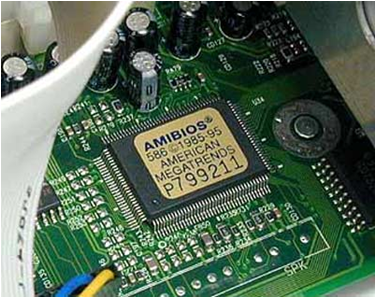Computer
An electronic device operating under the control of instructions stored in its own memory that can accept, manipulate, and store data
Hardware components include:
- Central processing unit (CPU)
- Primary storage
- Secondary storage
- Input device
- Output device
- Communication device
Computer hardware functions
Input
- Keyboards, mouse, optical scanners
- Convert data into electronic form
Processing
- Central Processing Unit (CPU)
- Arithmetic-logic unit performs the arithmetic functions
- Control unit
Output
- Video display units, printers, etc.
- Convert electronic information into human-intelligible form
Storage
- Primary Storage Unit or memory
- Secondary Storage
- Magnetic disks and Optical disks
Control
- Control unit of the CPU
- Controls the other components of the computer
Computer System Components
Central Processing Unit
Central processing unit (CPU) (or microprocessor) -
the actual hardware that interprets and executes the program (software) instructions and coordinates how all the other hardware devices work together
Control unit -
Interprets software instructions and literally tells the other hardware devices what to do, based on the software instructions
Arithmetic-logic unit (ALU) -
Performs all arithmetic operations (for example, addition and subtraction) and all logic operations (such as sorting and comparing numbers)
Primary Storage
The computer’s main memory, which consists of the random access memory (RAM), cache memory, and the read-only memory (ROM) that is directly accessible to the CPU
Random access memory (RAM) - the computer’s primary working memory, in which program instructions and data are stored so that they can be accessed directly by the CPU via the processor’s high-speed external data bus
Volatility : do not retain its contents when the power is switched off
Save work frequently
Cache memory
Small unit of ultra-fast memory
Used to store recently accessed or frequently accessed data > CPU does not have to retrieve this data from slower memory such as RAM.
Read Only Memory (ROM)
- The portion of a computer’s primary storage that does not lose its contents when one switches off the power > Permanent storage
- Can be read but cannot be overwritten
- Store start-up program : frequently used programs burnt into chips during manufacturing (Called firmware)
Peripherals
Peripheral is generic name for all input, output, and secondary storage devices that are part of the computer system but are not part of the system unit (i.e. CPU & primary storage)
Input Devices
equipment used to capture information and commands
Manual input devices -
Joystick
Keyboard
Microphone
Automated input devices -
Bar code scanner
Digital camera
Magnetic ink character reader
Output Devices
- Video displays
- Cathode ray tube (CRT) like a television
- Most desktop PC screens
- Liquid crystal displays (LCD's)
- Laptop and PDAs, some PCs
- Printed Output
- Inkjet printer
- Spray ink on page
- Laser printer
- Electrostatic process like photocopying machine
- Voice response systems
Secondary Storage Devices
Magnetic Disks
Floppy disks
Magnetic disk inside a plastic jacket
Hard disk drives
Magnetic disk, access arms, and read/write heads in sealed module
RAID (Redundant arrays of independent disks)
Disk arrays of interconnected hard disk drives
Fault tolerant with multiple copies on several disks
- Main memory provides only small amount of storage area for data, instruction, information.
- Computer needs store larger amount of data, instruction and information, more permanently than primary memory Q Secondary storage devices
Computer Storage Fundamentals
Binary representation
- Data are processed and stored in computer system through the presence or absence of signals
- Either ON or OFF
ON = number 1
OFF = number 0
Bit and Byte
Bit (short for binary digit)
- Smallest element of data
- Either zero or one
Byte
- Group of eight bits which operate as a single unit
- Represents one character or number
Communication Devices
- equipment used to send information and receive it from one
location to another
Dial-up access
Cable
Digital subscriber line
Wireless
Satellite









No comments:
Post a Comment